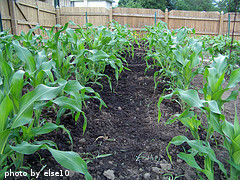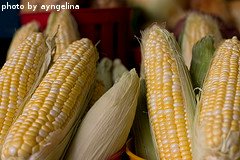Planting Corn? You've Come to the Right Place!
Planting corn in your garden is simple. Corn seed is usually sown directly in a well tilled garden. It's very important that the soil has been thoroughly and deeply tilled for the plants to develop an adequate root system. Because the plants will reach 5-8 feet tall (depending on the variety), a well developed root system is vital to support the plant.
Corn should be planted at least 2 weeks after the last expected frost in your area. By this point, the soil should have warmed up enough, to at last 60 degrees F. Depending on your local climate, you may choose to wait to plant corn until early in the summer. This way, the corn will mature in the fall. If you're looking for corn and corn stalks to be utilized in fall decorations, it's usually better to wait to plant it until about 100-110 days before the first expected frost in your area. On the other hand, if you live in a milder climate and want sweetcorn for your 4th of July picnic, you'll need to plant it as early as possible.
Steps For Planting Corn
Use a hoe and create rows approximately 2 inches deep and 3 feet apart. Sow the corn seed 6 inches apart in the row and cover with 2 inches of soil. Water the rows in well.
In our own garden, we typically fertilize the soil and ammend it about a week before we plant our sweet corn. After tilling, we scatter a balanced granular fertilizer at a rate of about 1 pint per 100 square feet of garden space. We also scatter pulverized lime as our soil is a bit acidic and lacks calcium. We then till again, working these additives into the soil. After that, we water them in well. 5-7 days later, we till the ground one more time and then build raised rows. We use a shovel to create rows that are approximately 6 inches tall and 6 inches across. These raised rows guarantee that our dense, clay-like soil is loose and airy. They also serve a second purpose - we don't have to bend over quite as far to plant our corn seeds.

After the seedlings reach 2 inches tall, thin the plants to one every 12 inches. For those of you that don't know, thinning plants means selectively removing seedlings. Corn plants will take a bunch of water and nutrients from the soil during their life span. If the plants are growing too close together, problems may arise. The root systems will end up growing into each other. When plants have to battle each other for water and nutrients, they end up becoming stressed and rarely grow to full height or produce quality ears of corn. To solve this problem, seedlings are thinned to create adequate space between the plants. Thinning also allows you to selectively remove under-performing seedlings. To thin the plants, simply pull the seedlings to be removed out by the roots and toss them in your compost pile.
When planting corn, keep in mind the pollination aspect of the plant. Pollen forms in the tassles on top of the plants. This pollen needs to be transferred to the silks on the baby ears of corn in order for them to grow and mature. If the pollen doesn't land on the silks, the baby ear will never grow and develop kernels. The main way that this pollen is transferred from the tassles to the silks is by the wind blowing.
For this reason, corn is best planted in blocks of rows, rather than in 1 or 2 long rows. For example, if you want to dedicate 50 row feet to growing sweet corn, you're much better off planting 5 rows that are each 10 feet long, rather than 2 rows that are 25 feet long or worse yet, a 50 foot long single row. Sweet corn that is planted in blocks will be much more productive and have higher yields than corn that is grown in isolated rows.
Most of the time, sweet corn is not appropriate for growing in a container. However, if you have enough containers that can be placed close enough together, it is certainly possible. In addition, some newer varieties of sweet corn have been developed that are specifically meant to be grown in pots.
See, we told you planting corn was simple. The only thing left do is mulch and water your corn plants and watch them grow.

Click here for information about watering, fertilizing and mulching corn
Click here for information about harvesting corn
Click here for corn recipes
Click here to move from our Planting Corn page back to our Growing Sweet Corn main page
Click here to return to our Home page